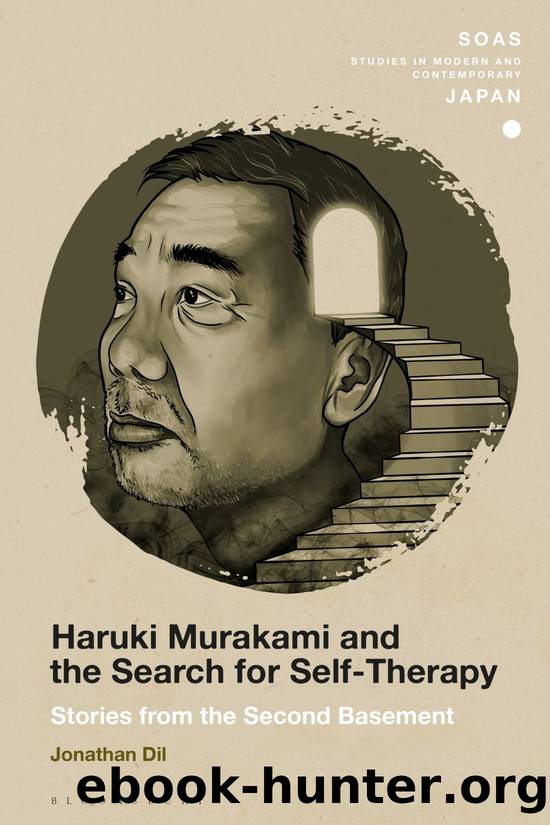Haruki Murakami and the Search for Self-Therapy by Jonathan Dil

Author:Jonathan Dil
Language: eng
Format: epub
ISBN: 9781350270565
Publisher: Bloomsbury Publishing
Published: 2022-01-19T00:00:00+00:00
This desire to see the âlump of deathâ is what caused her to cover her boyfriendâs eyes while riding on the back of his motorcycle, killing him and injuring herself. âYouâve got to really push the limits if youâre going to trick it into coming out,â she explains to TÅru. 96 For her, this gooshy something inside people is the only real thing in the world. 97 At one point, she pulls TÅruâs ladder up from the well, abandoning him down there and perhaps leaving him there to die. Someone else rescues TÅru before he has a chance to find out just how far she was willing to go.
This can all be seen as part of TÅruâs preparation. He must slowly strip himself of everything inessential, everything connected with everyday reality. Entering the well, he senses this separation from the world above and the lives of ordinary people: âI am no longer one of them, however. They are up there, on the face of the earth; I am down here, in the bottom of a well.â 98 Or as he puts it a few lines later, âThe break between âpeopleâ and me is now total.â 99 This is the first step of what Campbell describes as the heroâs journey, âdetachment or withdrawal,â the necessary transferring of âemphasis from the external to the internal world.â 100 This is similar territory to what we have already seen in A Wild Sheep Chase, but here the heroâs journey becomes more intentional. TÅru will make a conscious decision to commit to the quest and to follow it through to its end, even if it means death.
The main example Joseph Campbell offers of a hero who goes âforth of [their] own volitionâ is Theseus, who, when he learns of the half-bull, half-human Minotaur who is consuming human sacrifices in a labyrinth in Crete, immediately volunteers to kill the beast. 101 The Theseus story is one of the sources Murakami is borrowing from in Wind-Up Bird, even if TÅru takes a little longer than Theseus to make his decision. 102 There are numerous references to labyrinths in Wind-Up Bird, and when the character Ushikawa (Bull River) appears later in the story (or simply Bull as he is often calledââthe more I hear that, the more I feel like a real bull,â Ushikawa states), we know our hero is getting close to his final battle. 103 Ushikawa is not the Minotaur in the novel, however; he is simply its representative (Ushikawa works for Noboru, who is the real beast that must be confronted). The most important labyrinth in the novel is the hotel where Kumiko (or some part of her) lies. Each time TÅru manages to make his way to room 208, he is interrupted by a knock at the door and warned to leave, but in the end, he will need to stay and face whoever or whatever is waiting for him on the other side.
Before this climactic encounter, though, there is an earlier one where
Download
This site does not store any files on its server. We only index and link to content provided by other sites. Please contact the content providers to delete copyright contents if any and email us, we'll remove relevant links or contents immediately.
4 3 2 1: A Novel by Paul Auster(11792)
The handmaid's tale by Margaret Atwood(7450)
Giovanni's Room by James Baldwin(6810)
Asking the Right Questions: A Guide to Critical Thinking by M. Neil Browne & Stuart M. Keeley(5357)
Big Magic: Creative Living Beyond Fear by Elizabeth Gilbert(5354)
Ego Is the Enemy by Ryan Holiday(4958)
On Writing A Memoir of the Craft by Stephen King(4664)
The Body: A Guide for Occupants by Bill Bryson(4585)
Ken Follett - World without end by Ken Follett(4444)
Bluets by Maggie Nelson(4262)
Adulting by Kelly Williams Brown(4235)
Eat That Frog! by Brian Tracy(4149)
Guilty Pleasures by Laurell K Hamilton(4118)
White Noise - A Novel by Don DeLillo(3829)
The Poetry of Pablo Neruda by Pablo Neruda(3816)
Fingerprints of the Gods by Graham Hancock(3738)
Alive: The Story of the Andes Survivors by Piers Paul Read(3731)
The Book of Joy by Dalai Lama(3699)
The Bookshop by Penelope Fitzgerald(3619)
